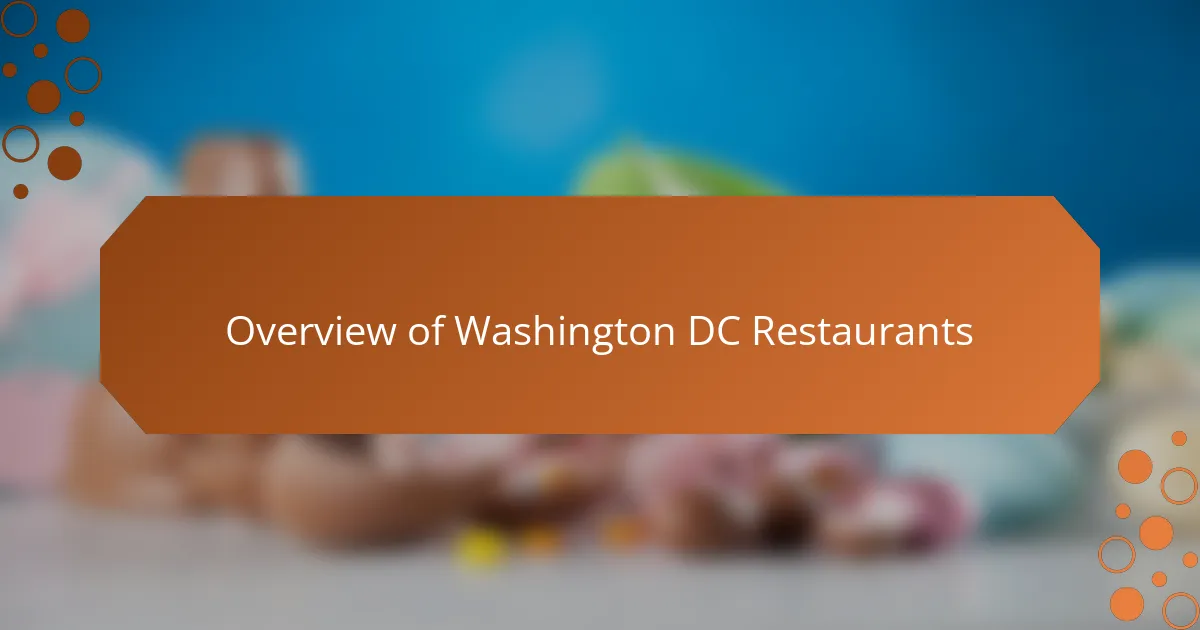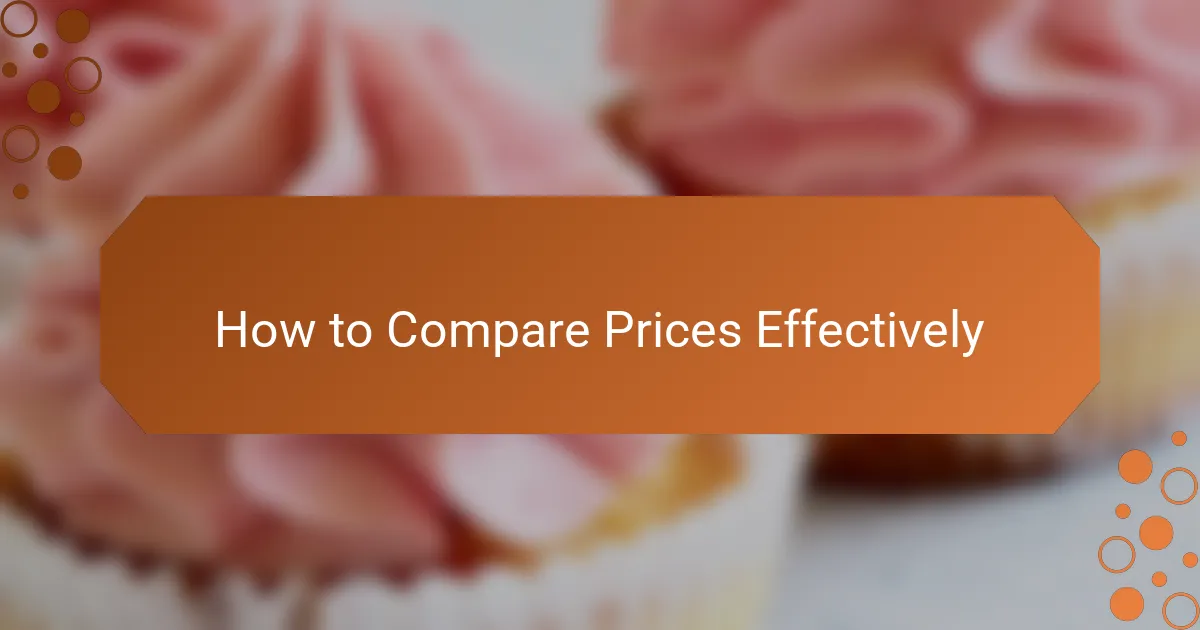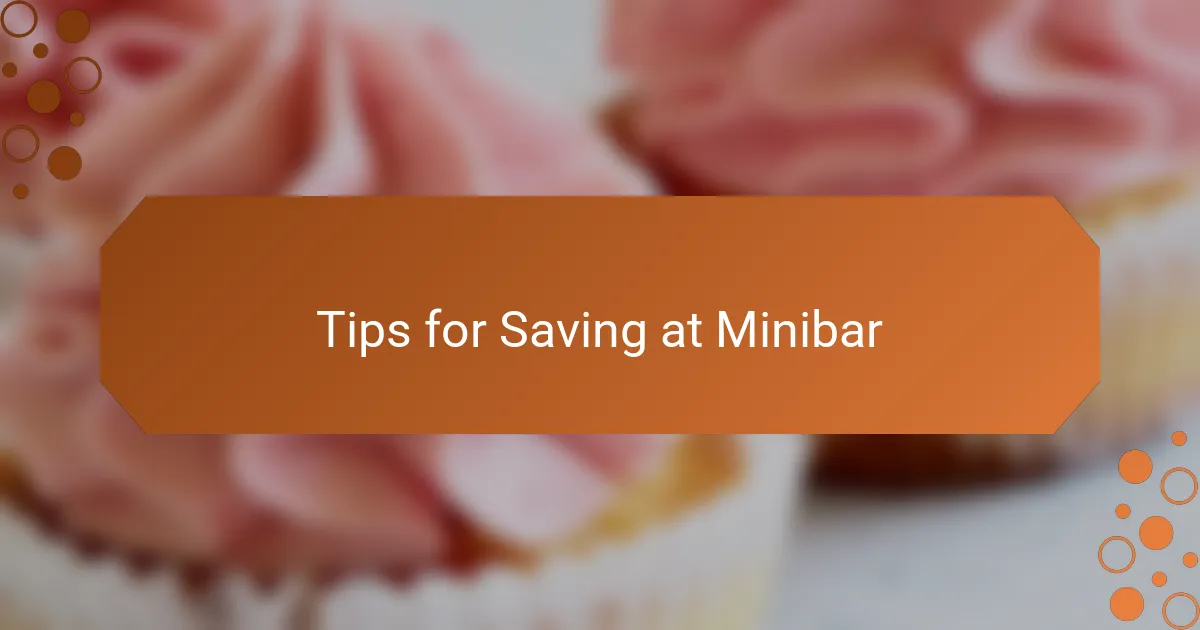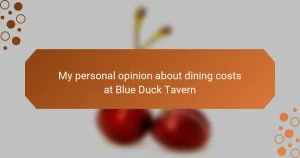Key takeaways
- Washington DC’s restaurant scene offers a rich diversity of cuisine, blending tradition and modernity.
- Minibar by José Andrés is a unique dining experience that emphasizes innovation, intimate settings, and culinary artistry.
- Restaurant prices are influenced by location, ingredient sourcing, and labor costs, which are crucial for quality dining experiences.
- Effective price comparison involves considering menu details, researching multiple sources, and being mindful of timing to find the best value.

Overview of Washington DC Restaurants
Washington DC’s restaurant scene is truly a microcosm of its vibrant culture. From classic steakhouses to innovative farm-to-table spots, there’s a richness that keeps me coming back. Have you ever felt that excitement when you find a place that perfectly balances tradition and modern flair? That’s the essence of DC dining.
What strikes me most is the diversity here. It’s not just about the type of cuisine but the stories behind each dish and chef. Walking into a DC restaurant often feels like stepping into a narrative where history and creativity blend seamlessly. It’s an experience that feeds more than just the appetite.
Yet, this variety can be overwhelming when trying to decide where to eat. I’ve often asked myself how to find the best value without missing out on quality. That’s why exploring options like Minibar by José Andrés has been both a culinary adventure and a practical challenge in price comparison.

What is Minibar by José Andrés
Minibar by José Andrés is not your typical restaurant—it’s a culinary laboratory where innovation meets storytelling on a plate. From the moment I first heard about it, I was intrigued by its reputation for pushing boundaries with playful techniques and avant-garde presentations. Have you ever tasted a dish that felt more like an experience than just food? That’s exactly what Minibar aims to deliver.
What truly fascinates me about Minibar is how it transforms dining into a multi-sensory journey. The menus are intimate, often limited to just a handful of guests per night, which creates this rare sense of exclusivity and connection. I remember feeling like I was part of something almost secretive, a rare glimpse into the mind of a culinary genius.
José Andrés, known for his creativity and humanitarian work, brings that passion into every bite at Minibar. It’s not just about eating; it’s about challenging what dining can be and making you think—what does flavor really mean when it’s reinvented at this level? For me, that question turned into an exciting quest to understand both the artistry and the price behind such an experience.

Factors Influencing Restaurant Prices
When I look at restaurant prices, I often wonder how much the location influences the numbers on the menu. In a city like Washington DC, where rents can be sky-high, it’s no surprise that those costs sneak their way into what diners pay. I’ve noticed that even the most creative chefs have to factor in these expenses to keep their doors open.
Another thing that caught my attention is how ingredient sourcing shapes prices. I’ve been to places where everything is locally grown and organic, and while the taste is incredible, it definitely reflects in the bill. Have you ever paused to think about the journey of your food, from farm to plate? That journey is packed with costs, and restaurants have to balance quality with affordability.
Labor costs also play a huge role, especially in an establishment like Minibar that thrives on precision and detail. The skilled hands crafting each dish bring expertise that doesn’t come cheap. I found myself appreciating the value far more after realizing how many hours go into perfecting each bite—a reminder that price isn’t just about food but about people behind the scenes.

How to Compare Prices Effectively
Comparing prices effectively starts with knowing exactly what you’re paying for. I used to glance at numbers and assume a higher price always meant better quality, but that’s not the full picture. Have you ever taken the time to break down the menu items and consider portion size, ingredient quality, and the overall dining experience? That kind of detailed look changed how I evaluate value.
One thing I’ve learned is the importance of checking multiple sources before deciding. When I was researching Minibar by José Andrés, I didn’t just rely on the restaurant’s website—I compared prices across reservation platforms and read reviews that mentioned portion and service. This approach gave me a clearer sense of what to expect, so I avoided surprises and felt more confident about spending my money.
Finally, I’ve found that timing matters a lot. Prices can fluctuate based on day, time, or special events. Have you ever noticed a difference in weekday versus weekend menus? I once booked a tasting experience on a quieter night and ended up with a slightly better price and more attentive service. Paying attention to these small details makes all the difference in getting the best value.

My Experience Comparing Minibar Prices
When I sat down to compare prices for Minibar by José Andrés, I realized it wasn’t as straightforward as just looking at the menu. I asked myself, what exactly am I paying for? The intricate presentation, the avant-garde techniques, and the limited seating all play into the cost, and understanding that helped me appreciate the price beyond just numbers.
I remember checking various online platforms and reading through countless reviews, trying to piece together whether the price matched the experience. Have you ever felt that moment of doubt—wondering if the price justified the experience? For me, this research turned into an adventure itself, revealing how much value people found in each carefully crafted dish versus the raw cost.
One thing that surprised me was how timing affected the price. Booking on a less busy night gave me not only a better rate but also a more relaxed atmosphere. It made me think, is a slight price difference worth the upgrade in experience? In this case, the answer was a clear yes, and it reminded me that price comparison is as much about timing and context as it is about numbers.

Tips for Saving at Minibar
One tip I found incredibly useful for saving at Minibar is to keep an eye on the booking times. Have you ever noticed how prices can dip during off-peak days? I snagged a reservation on a Wednesday evening and not only saved a bit, but the intimate setting felt even more exclusive without the weekend crowd.
Another strategy I swear by is exploring different reservation platforms. It sounds simple, but I was surprised to find slight price variations or special offers when comparing sites. It made me think—why pay full price right away when a little digging can reveal hidden deals?
Lastly, don’t underestimate the value of signing up for newsletters or alerts from Minibar or José Andrés’ group. I didn’t expect to get insider info on promotions or new tasting menus, but those emails have saved me money while keeping me in the loop. It’s like having a VIP pass to savings without sacrificing the experience.


